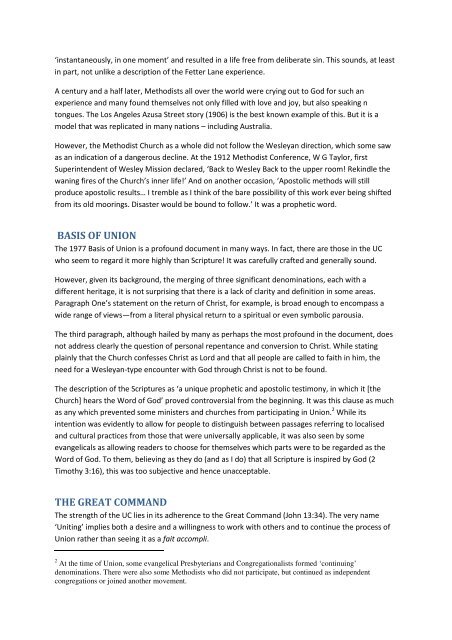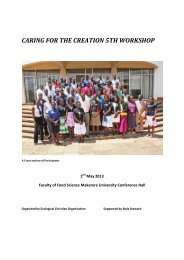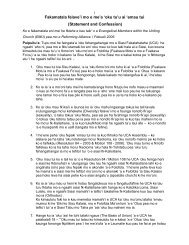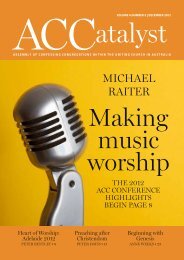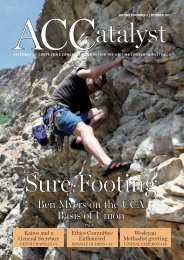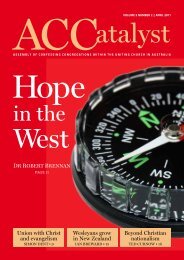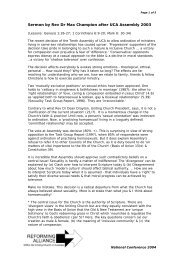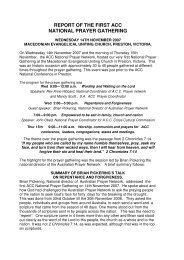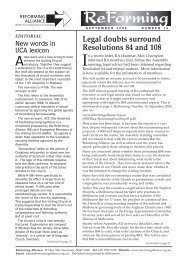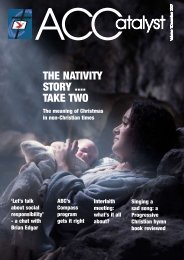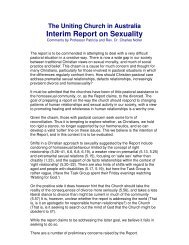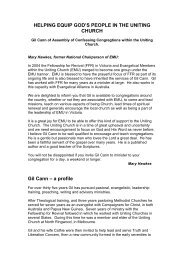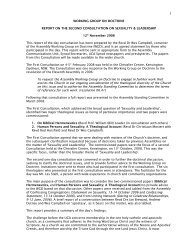where are we now? - Assembly of Confessing Congregations
where are we now? - Assembly of Confessing Congregations
where are we now? - Assembly of Confessing Congregations
You also want an ePaper? Increase the reach of your titles
YUMPU automatically turns print PDFs into web optimized ePapers that Google loves.
‘instantaneously, in one moment’ and resulted in a life free from deliberate sin. This sounds, at least<br />
in part, not unlike a description <strong>of</strong> the Fetter Lane experience.<br />
A century and a half later, Methodists all over the world <strong>we</strong>re crying out to God for such an<br />
experience and many found themselves not only filled with love and joy, but also speaking n<br />
tongues. The Los Angeles Azusa Street story (1906) is the best k<strong>now</strong>n example <strong>of</strong> this. But it is a<br />
model that was replicated in many nations – including Australia.<br />
Ho<strong>we</strong>ver, the Methodist Church as a whole did not follow the Wesleyan direction, which some saw<br />
as an indication <strong>of</strong> a dangerous decline. At the 1912 Methodist Conference, W G Taylor, first<br />
Superintendent <strong>of</strong> Wesley Mission decl<strong>are</strong>d, ‘Back to Wesley Back to the upper room! Rekindle the<br />
waning fires <strong>of</strong> the Church’s inner life!’ And on another occasion, ‘Apostolic methods will still<br />
produce apostolic results… I tremble as I think <strong>of</strong> the b<strong>are</strong> possibility <strong>of</strong> this work ever being shifted<br />
from its old moorings. Disaster would be bound to follow.’ It was a prophetic word.<br />
BASIS OF UNION<br />
The 1977 Basis <strong>of</strong> Union is a pr<strong>of</strong>ound document in many ways. In fact, there <strong>are</strong> those in the UC<br />
who seem to regard it more highly than Scripture! It was c<strong>are</strong>fully crafted and generally sound.<br />
Ho<strong>we</strong>ver, given its background, the merging <strong>of</strong> three significant denominations, each with a<br />
different heritage, it is not surprising that there is a lack <strong>of</strong> clarity and definition in some <strong>are</strong>as.<br />
Paragraph One’s statement on the return <strong>of</strong> Christ, for example, is broad enough to encompass a<br />
wide range <strong>of</strong> views—from a literal physical return to a spiritual or even symbolic parousia.<br />
The third paragraph, although hailed by many as perhaps the most pr<strong>of</strong>ound in the document, does<br />
not address clearly the question <strong>of</strong> personal repentance and conversion to Christ. While stating<br />
plainly that the Church confesses Christ as Lord and that all people <strong>are</strong> called to faith in him, the<br />
need for a Wesleyan-type encounter with God through Christ is not to be found.<br />
The description <strong>of</strong> the Scriptures as ‘a unique prophetic and apostolic testimony, in which it [the<br />
Church] hears the Word <strong>of</strong> God’ proved controversial from the beginning. It was this clause as much<br />
as any which prevented some ministers and churches from participating in Union. 2 While its<br />
intention was evidently to allow for people to distinguish bet<strong>we</strong>en passages referring to localised<br />
and cultural practices from those that <strong>we</strong>re universally applicable, it was also seen by some<br />
evangelicals as allowing readers to choose for themselves which parts <strong>we</strong>re to be regarded as the<br />
Word <strong>of</strong> God. To them, believing as they do (and as I do) that all Scripture is inspired by God (2<br />
Timothy 3:16), this was too subjective and hence unacceptable.<br />
THE GREAT COMMAND<br />
The strength <strong>of</strong> the UC lies in its adherence to the Great Command (John 13:34). The very name<br />
‘Uniting’ implies both a desire and a willingness to work with others and to continue the process <strong>of</strong><br />
Union rather than seeing it as a fait accompli.<br />
2 At the time <strong>of</strong> Union, some evangelical Presbyterians and Congregationalists formed ‘continuing’<br />
denominations. There <strong>we</strong>re also some Methodists who did not participate, but continued as independent<br />
congregations or joined another movement.


